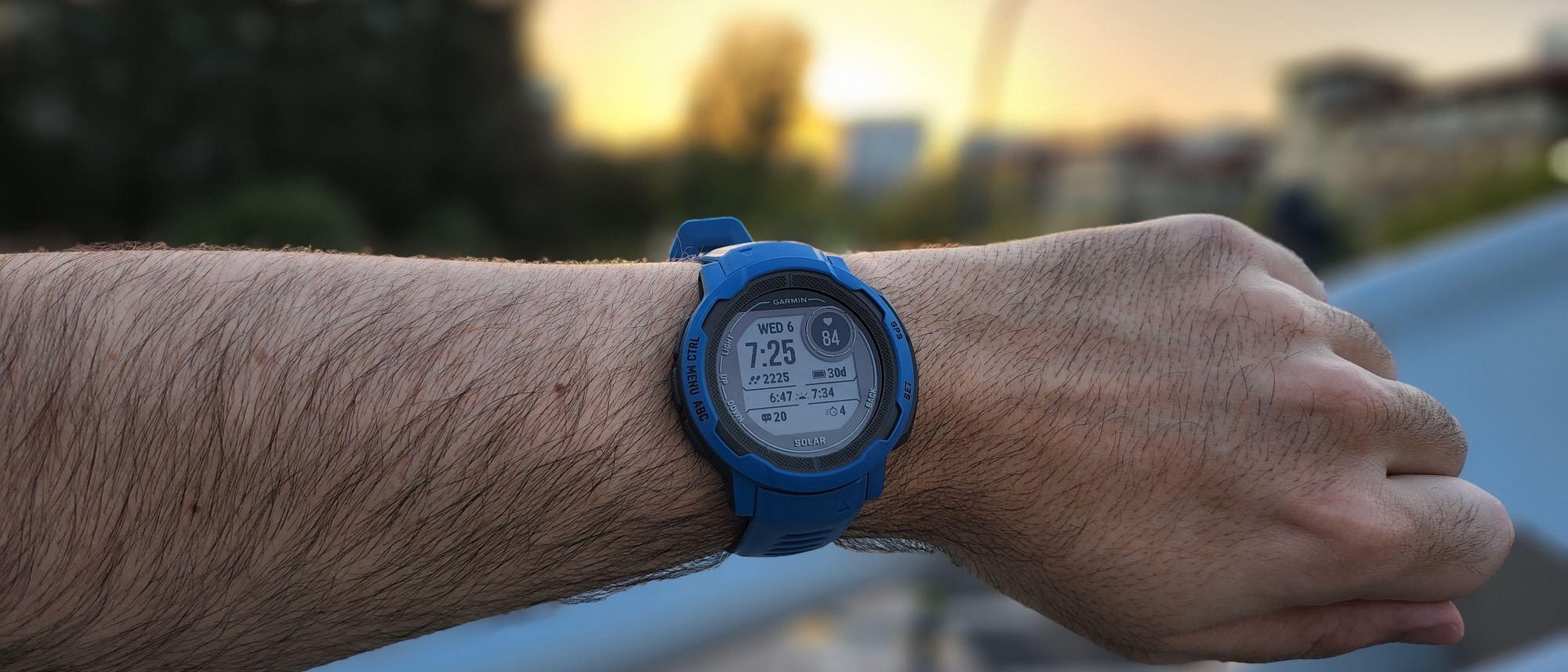Android Central Verdict
The Garmin Instinct 2 Solar is a rugged fitness smartwatch that can track a full day and night of heart rate monitoring off of a few hours of time outdoors, using UV rays so it never dies on the job. It's a major improvement on the original Instinct in design, battery life, and software. The monochrome display is readable in direct sunlight but a downgrade compared to most other Garmin watches. The shrunken Instinct 2S is shorter-lived but its solar panel counterbalances the battery life woes of most small watches.
Pros
- +
Unstoppable battery with decent solar recharging
- +
Bright MIP display upgraded from Instinct 1
- +
Comes in two sizes with several special editions
- +
Works with Garmin Pay and Connect IQ
Cons
- -
Fairly expensive for Solar version
- -
No music storage or calls
- -
Maps are too barebones
Why you can trust Android Central
Garmin sells a ridiculous number of watches. Vivoactive offers simple all-around tracking, Forerunner targets runners and triathletes, Venu adds an AMOLED touch display, Fenix caters to hardcore adventurers — and you'll even find specialized watches built for pilots, golfers, or scuba divers. Compared to all those, the Garmin Instinct 2 isn't particularly exciting, prioritizing ruggedness and battery life over any other defining characteristics.
Having recently reviewed the Venu 2 Plus, switching to the Instinct 2 Solar was an adjustment, to put it mildly. You lose the gorgeous touchscreen capable of exercise animations, voice assistant, Bluetooth calling support, and music storage, despite both watches costing the same. You're trading all that to double the GPS battery life and triple the standard smartwatch life. Is it worth it?
Surprisingly, it might be for some people. Running with the Instinct 2 Solar has plenty of upsides compared to Garmin's pseudo-lifestyle watch, especially if you're someone that spends a lot of time outdoors and always keeps your phone on hand. Aside from absent features you may not care about and some minor nitpicks, the Garmin Instinct 2 Solar is an excellent no-nonsense device, numbering among the best running watches available for long-distance runners and Ron Swanson-esque nature-lovers.
Garmin Instinct 2: Price, Availability, and Models
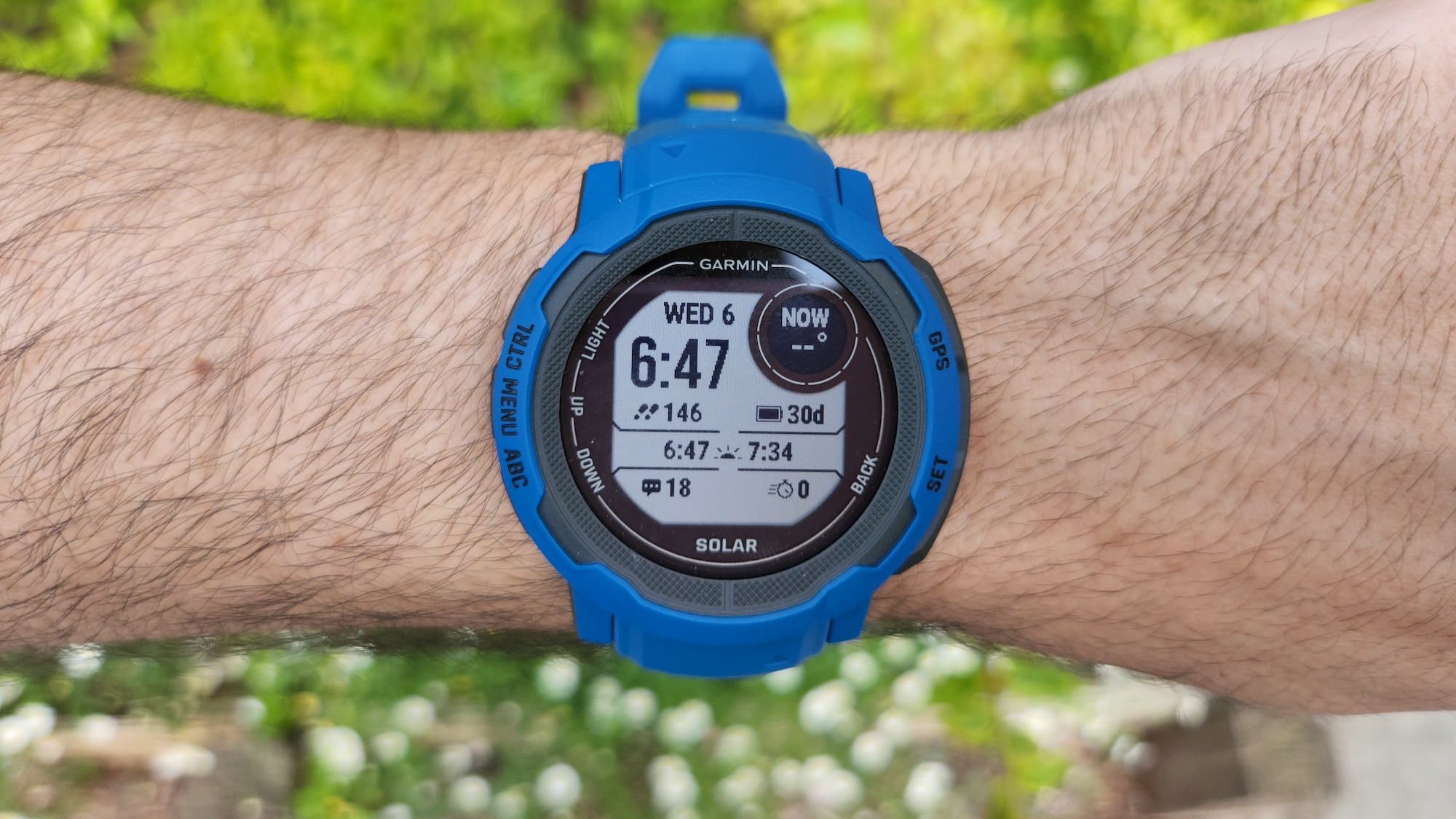
The Garmin Instinct 2 Solar launched February 9, costs $450, and is available from several major retailers, including Amazon, Best Buy, REI, and Garmin itself.
You'll also find the Garmin Instinct 2S Solar, which costs the same but has a smaller case size (45mm vs. 40mm) and surprisingly downgraded battery life (48 hours vs. 28 hours of GPS tracking). It ensures people with smaller wrists can enjoy ruggedness without as bulky of a design.
The Garmin Instinct 2 without a Solar Panel costs just $350, and still gets decent battery life on par with the 2S Solar, but lacks Garmin Pay if that's a deal-breaker.
Garmin also sells several special editions, most with both Solar and non-Solar editions that are $100 apart in cost:
- Instinct 2 Tactical ($400/$500): Designed for military use, it has a night vision goggles compatibility mode, a stealth mode that disables all GPS and wireless data, a kill switch that auto-deletes all stored data, and a "jumpmaster mode" for calculating high-altitude jumps.
- Instinct 2 Surf ($400/$500): Offers dedicated tide data and surfline conditions, while tracking number of surfed waves and maximum speed. Also has dedicated modes for windsurfing and kiteboarding.
- Instinct 2 Dezl ($400): Designed for long-haul truck drivers, with short workouts, break planning, and weigh station notifications. No solar version.
- Instinct 2 Camo ($400/$500): A simple camo pattern without any feature upgrades.
Garmin Instinct 2 Solar: What you'll love
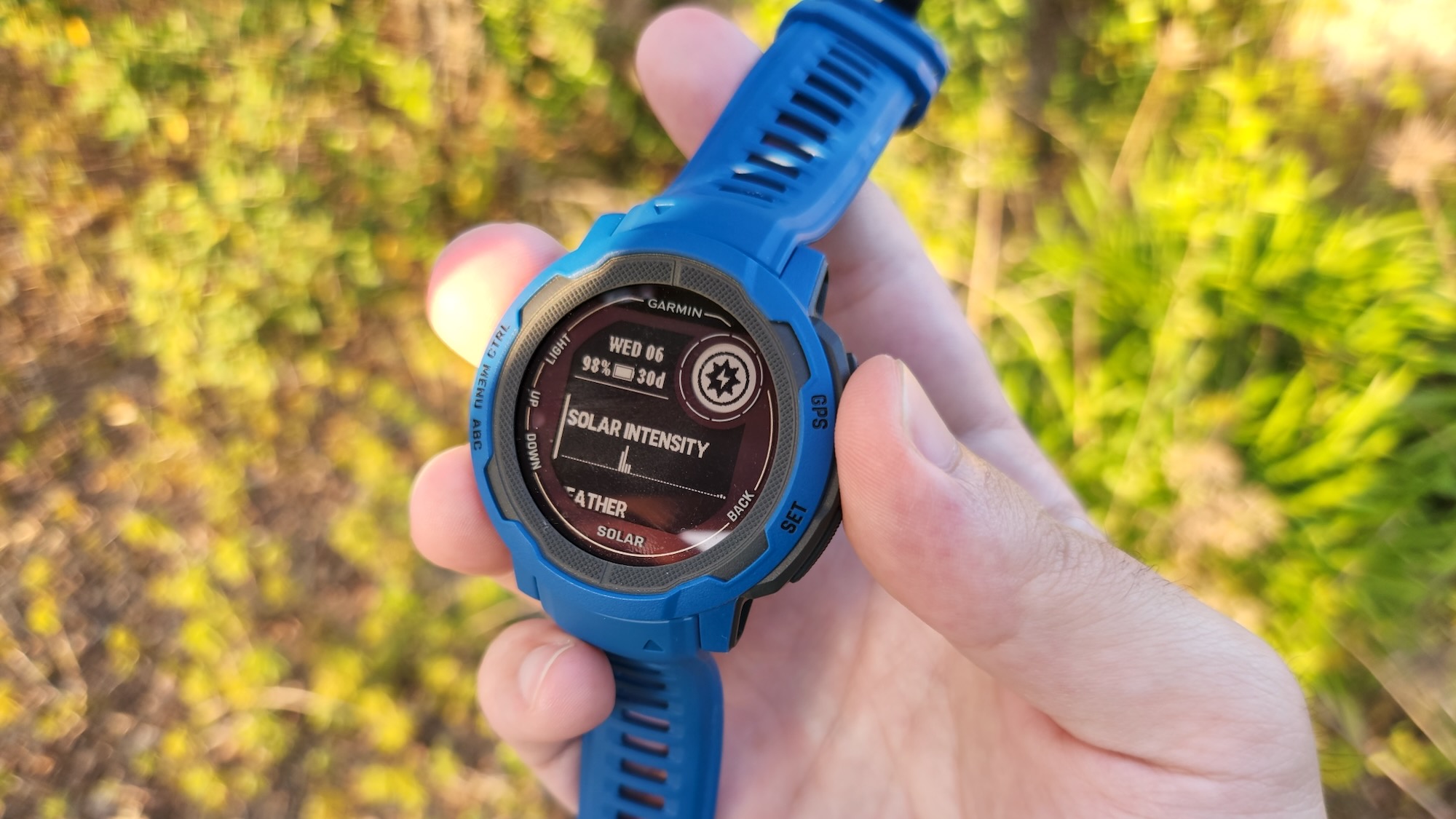
I unboxed the Instinct 2 Solar the night before a planned half marathon and found it had 19 days of juice left, slightly more than half of its 31-day estimated maximum. On a whim, I decided not to charge it and see how it would hold up.
Most fitness smartwatches claim to last a week or two, but that's only if you use HRM and nothing else; start using GPS, and it'll burn through the battery in a few hours. But my 2:10 half in sunny Oakland weather dipped the Instinct to 17 days, only losing less than 10% of its capacity.
Two weeks later, including 8 hours total of GPS-tracked running during that period, it finally hit "Low" battery. It might have lasted longer, but my job (and video games) prevent me from getting outside enough. So I stuck the almost-dead Instinct 2 Solar on my west-facing balcony for the afternoon; by evening, it had risen back to 4 days of battery life, equal to a few hours of tracking. There's no other way to describe this except really cool.
| Battery mode | Hours w/out solar | Hours with solar |
|---|---|---|
| Smartwatch | 28 days | "Unlimited" |
| Battery Saver Watch Mode | 65 days | "Unlimited" |
| GPS | 30 hours | 48 hours |
| Max Battery GPS Mode | 70 hours | 370 hours |
| Expedition GPS Activity | Up to 32 days | "Unlimited" |
Your mileage will vary based on where you live and when you tend to work out. Garmin says the Instinct 2 Solar sports a 30-hour GPS capacity or 48 hours assuming "50,000 lux conditions." That number equates to an overcast day, so you don't necessarily need direct sunlight; but if you tend to train during early mornings or evenings or don't live in a sunny area, you won't benefit as much from the Solar Panel display. Unless, of course, you have an outdoor day job.
In that case, assuming you're only using the HRM or GPS with Ultratrac (which checks your location every minute), a few hours in the sun will counterbalance the minimal battery usage and keep the Instinct 2 Solar running indefinitely.
Other Garmin Solar models cost several hundred dollars more (Enduro) or have advanced displays that solar energy only slightly counterbalances (Fenix). The Instinct 2 Solar is the only accessible model.
Plus, people with smaller wrists can try the Instinct 2S Solar, which costs the same but dips to a 40mm case and 43g weight. It's no longer rated as "unlimited" but has a 50-day solar smartwatch mode estimate and 28 GPS hours with solar; that's much better than most 40mm Garmin watches, such as the Vivoactive 4S (7 days, 15 hours).
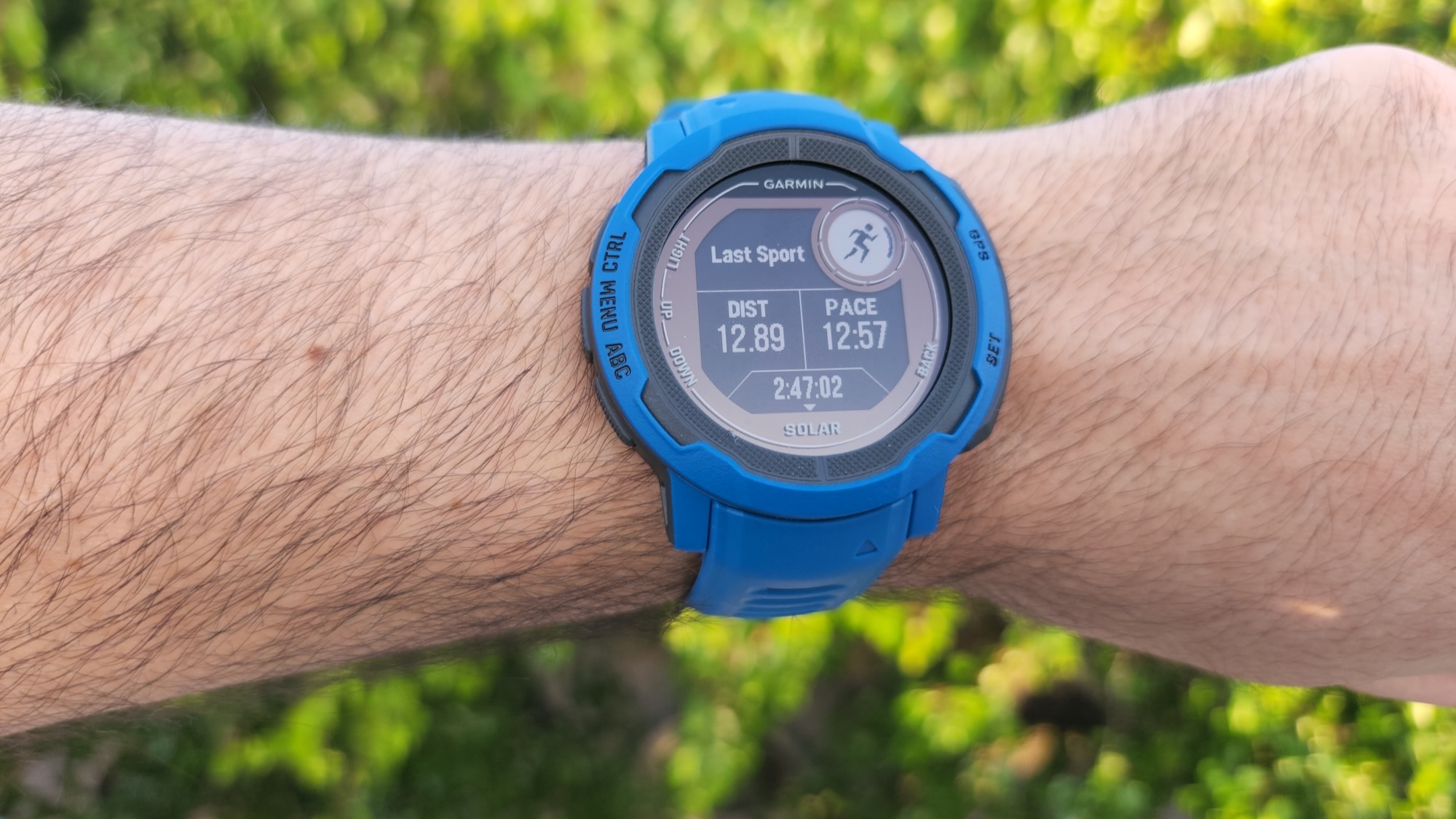
Speaking of the display, it's a transflective, monochrome memory-in-pixel (MIP) display at 0.9 inches and 176 x 176 pixels. Even cheaper Garmin watches like the Forerunner 55 are slightly more pixel-dense and support multiple colors, so this might belong in the "you won't love this" category. But it's a big step up on the Instinct 1, which only hit 128 x 128, and the lower resolution and lack of colors help the battery hit such crazy highs.
In practice, the MIP display is much more visible in direct sunlight than any LCD or AMOLED, and the resolution is high enough that notifications and small metric data are fully readable. Unless you're really attached to colorful watch faces, the Instinct 2 display works perfectly well for focused athletes.
| Category | Garmin Venu 2 Plus |
|---|---|
| Operating System | Garmin OS (iOS & Android compatible) |
| Dimensions & weight (Instinct 2) | 45 x 45 x 14.5 mm, 53 grams |
| Dimensions & weight (Instinct 2S) | 40 x 40 x 13.3 mm, 43grams |
| Colors (2) | Graphite, Electric Lime, Mist Gray, Tidal Blue |
| Colors (2S) | Graphite, Deep Orchid, Poppy, Mist Gray, Neo Tropic |
| Material | Case & bezel: fiber-reinforced polymer |
| Display | 0.9" Memory in Pixel, Corning Gorilla Glass 3, Solar Panel (optional) |
| Resolution | 176x176 |
| Bands | 22mm, quick release |
| Sensors | GPS/GLONASS/GALILEO, HRM, barometric altimeter, compass, gyroscope, accelerometer, thermometer, pulse ox |
| Connectivity | NFC (Garmin Pay), Bluetooth, ANT+ |
| Music storage and controls | 🚫 |
| Mic and speaker | 🚫 |
The Garmin Instinct 2 design falls in line with most of its peers: three buttons on the left for the backlight, scroll up, and scroll down buttons, and two right buttons for starting workouts/ selecting options and the Back button. I strongly prefer buttons to touchscreens during races and workouts, and Garmin makes it easy to start or pause an activity or navigate through menus without false touches or futile swiping.
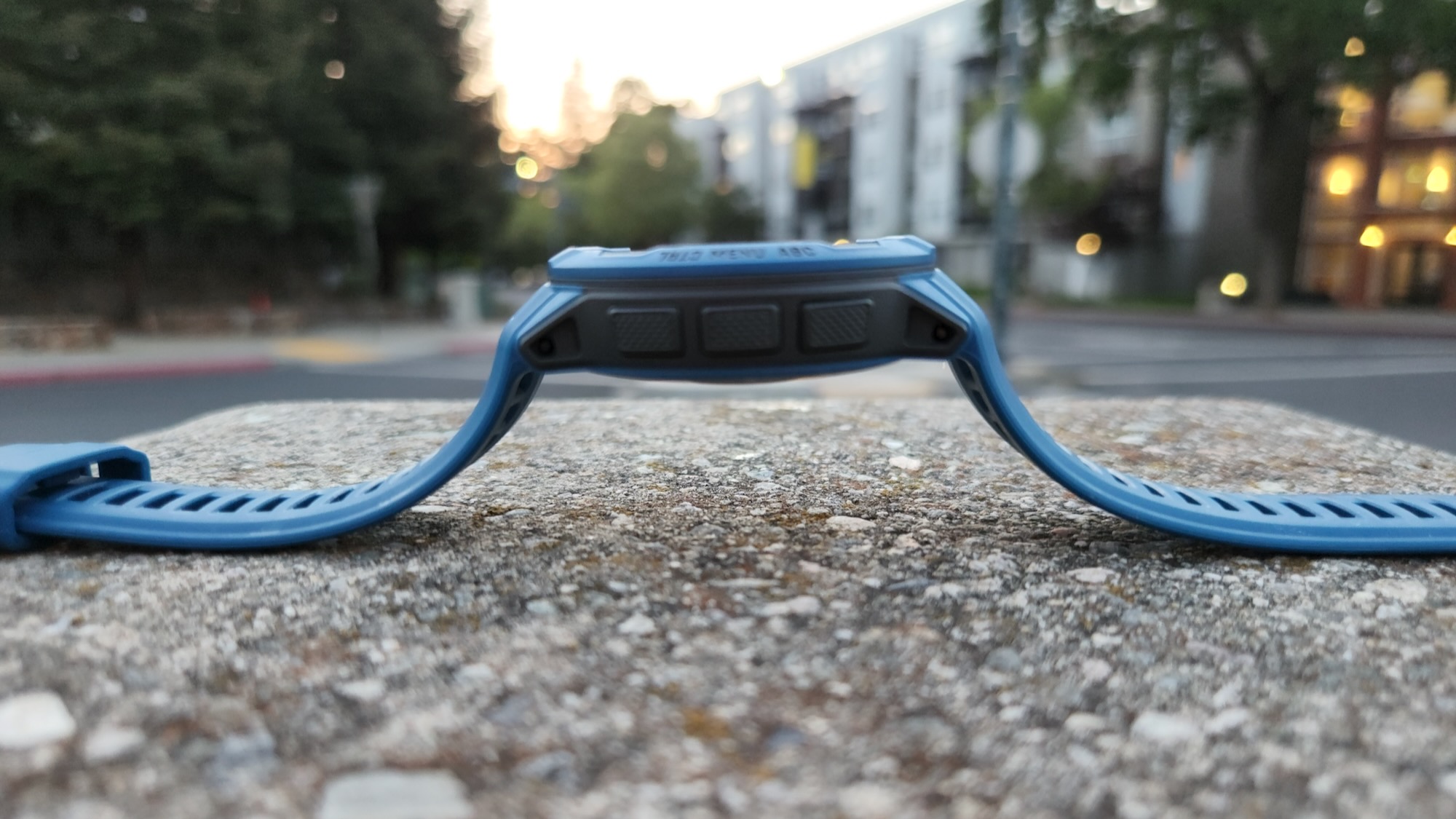
Looking back on the original Garmin Instinct, it's surprising how little data Garmin gave you with it besides basics like Body Battery, sleep/stress tracking, and optional Pulse Ox. The Instinct 2 has those, but also adds HIIT workouts, new sports modes like golf, mountain biking metrics, VO2 Max, training and recovery time suggestions, and training effect/load, among other new metrics. It makes the Instinct 2 much more useful than its predecessor.
It uses the upgraded Elevate 4.0 sensor, the same one found in the Venu 2 and Fenix 7, giving you more accurate heart rate and SpO2 tracking. This allowed Garmin to patch the Instinct 2 in July to add heart rate variability status. This feature allows the watch to better track your stress during the day — and therefore better calculate your Body Battery and sleep recharge.
Otherwise, the core Instinct conceit is exploration, so both watches provide a few tools in line with that. The 3-axis compass will point you in the right direction, while the altimeter and barometer measure altitude and weather, respectively. Tracback uses GPS data to see where you've gone and the compass to direct you back that direction in case you're lost. Plus you can pre-download GPX files to find your way to specific waypoints on a hike.
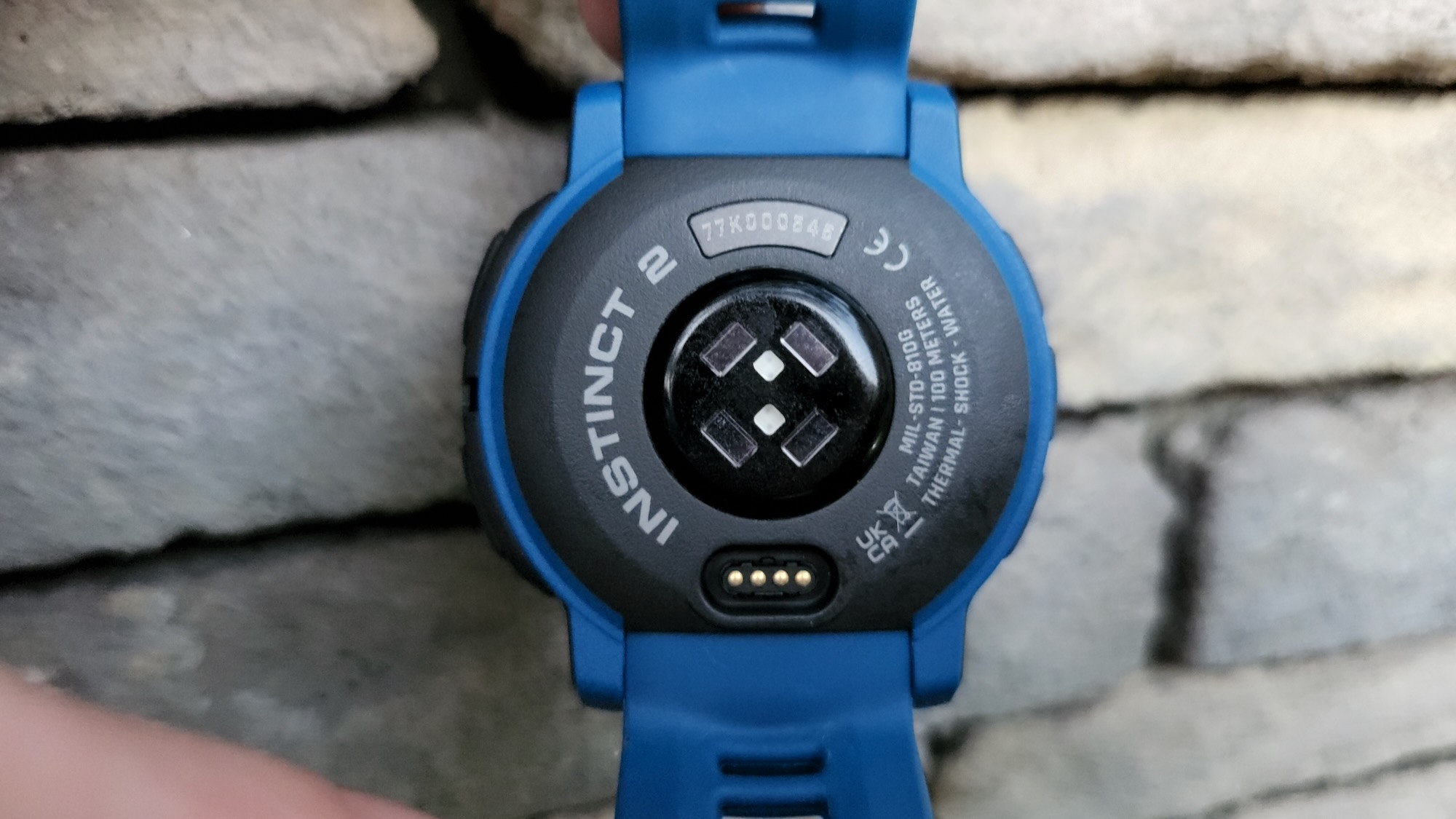
Otherwise, most of the perks with this watch retread old ground for anyone who's used a Garmin watch before. GPS data and heart rate tracking appeared to be very consistent, matching my running routes and level of intensity.
After completing enough workouts, Garmin Connect provides detailed metrics on your current fitness level without a monthly subscription. Then, once you prepare to start a workout, you'll receive a suggested pace and time that matches your fitness and will have a good training effect.
Garmin Instinct 2 Solar: What you won't love
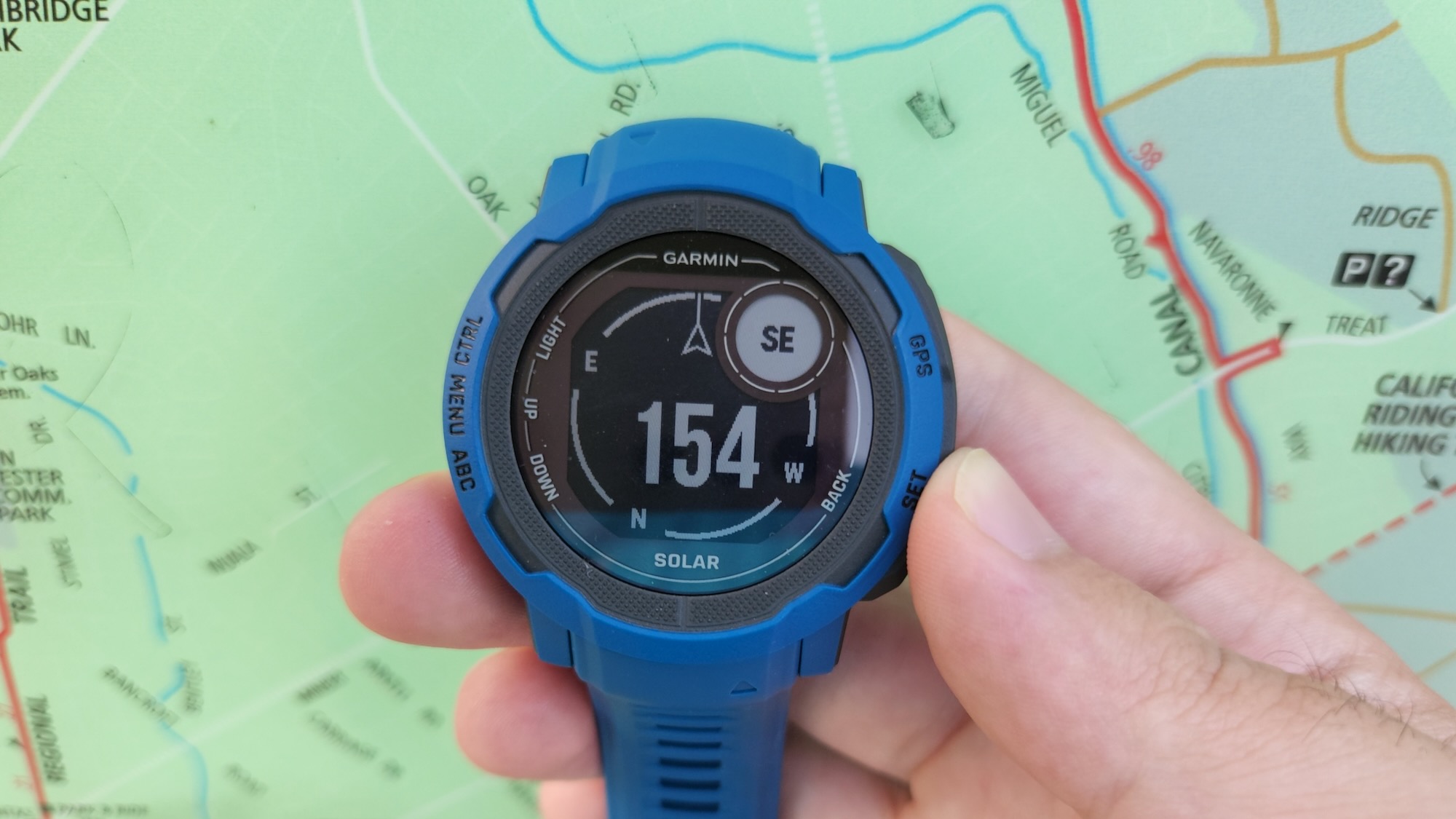
Even if the Instinct 2 makes major strides over the original, that doesn't mean it offers a complete experience, or that everyone should spend such a high price tag just for long battery life.
If you're a runner, then the Forerunner 245 or 55 may be better if you prefer a watch that holds your hand a bit more. The Instinct 2 offers a decent amount of data, but misses out on Forerunner tools like live pace guidance (aka Pacepro), cadence alerts, estimated finish time, Garmin Coach, and so on. It just doesn't have the same specialization.
Instead, it's marketed as "bold, rugged and ready for adventure." But for actual trailblazing adventures, the monochrome Instinct 2 display doesn't support onboard maps. So a tool like Tracback involves following an arrow and a black line on a blank inch-sized display — it's not very intuitive to use! Even if you download a GPX map of your destination in advance, it's hard to navigate a map with buttons instead of a touchscreen, like you'd get with an expensive Fenix smartwatch.
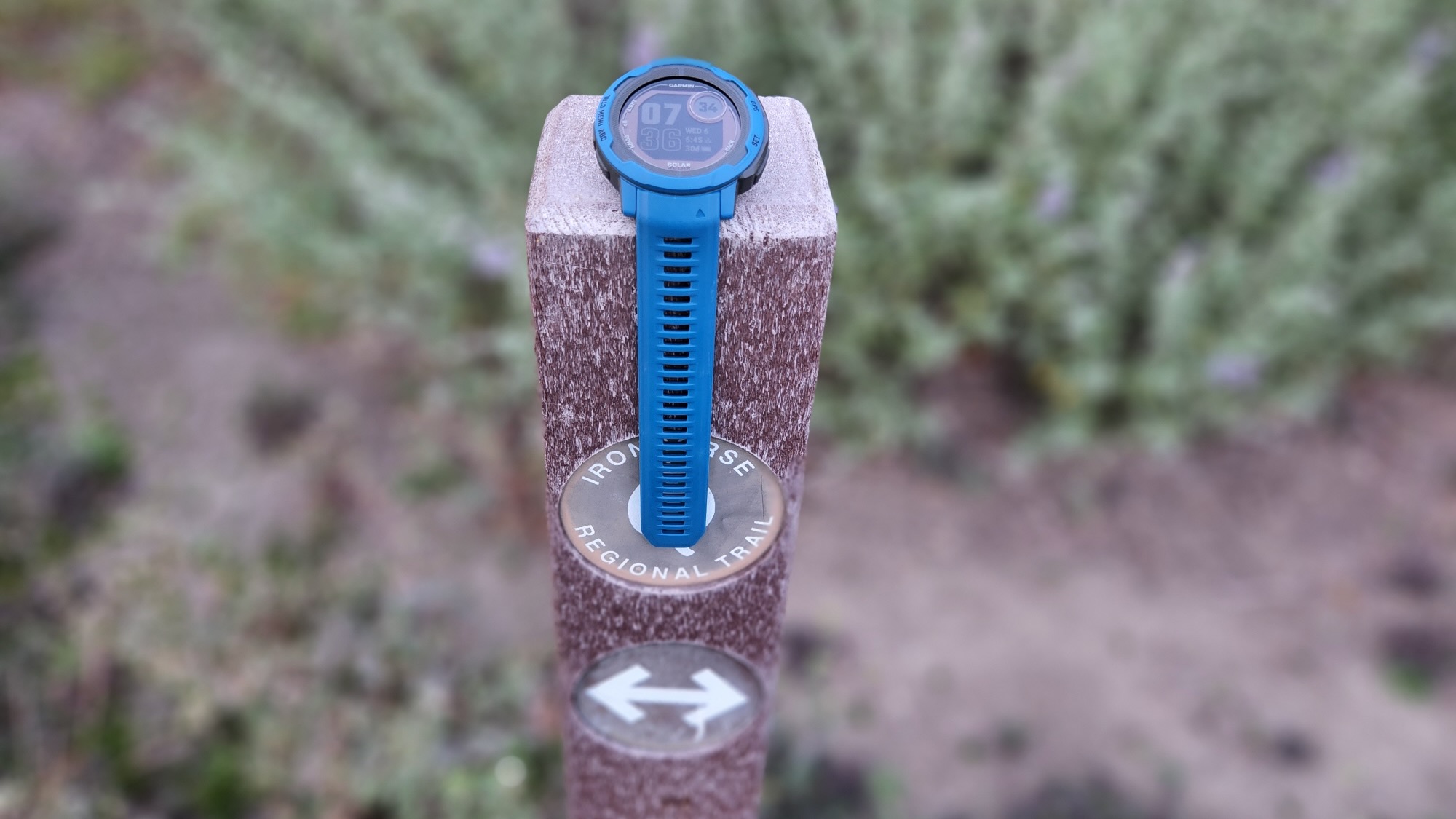
Lastly, as I mentioned in the intro, the Instinct 2 is fairly basic in terms of connectivity compared to a Venu 2 Plus. You can't control music playback, answer calls, ask Google Assistant a question, or see live animations of how to complete an exercise. For focused athletes, all of these would just be a distraction; but for people used to lifestyle smartwatches, the Instinct 2 will be far too limited.
All that aside, it isn't fair to lament that the Instinct 2 isn't a different watch entirely. Judging it on its own merits, it's an excellent device for a variety of sports that gives you plenty of data while letting you forget you're wearing it, similar to a fitness tracker. The only difference is that the Instinct 2 is heavier and more expensive than your average fitness band.
Garmin Instinct 2 Solar: Competition
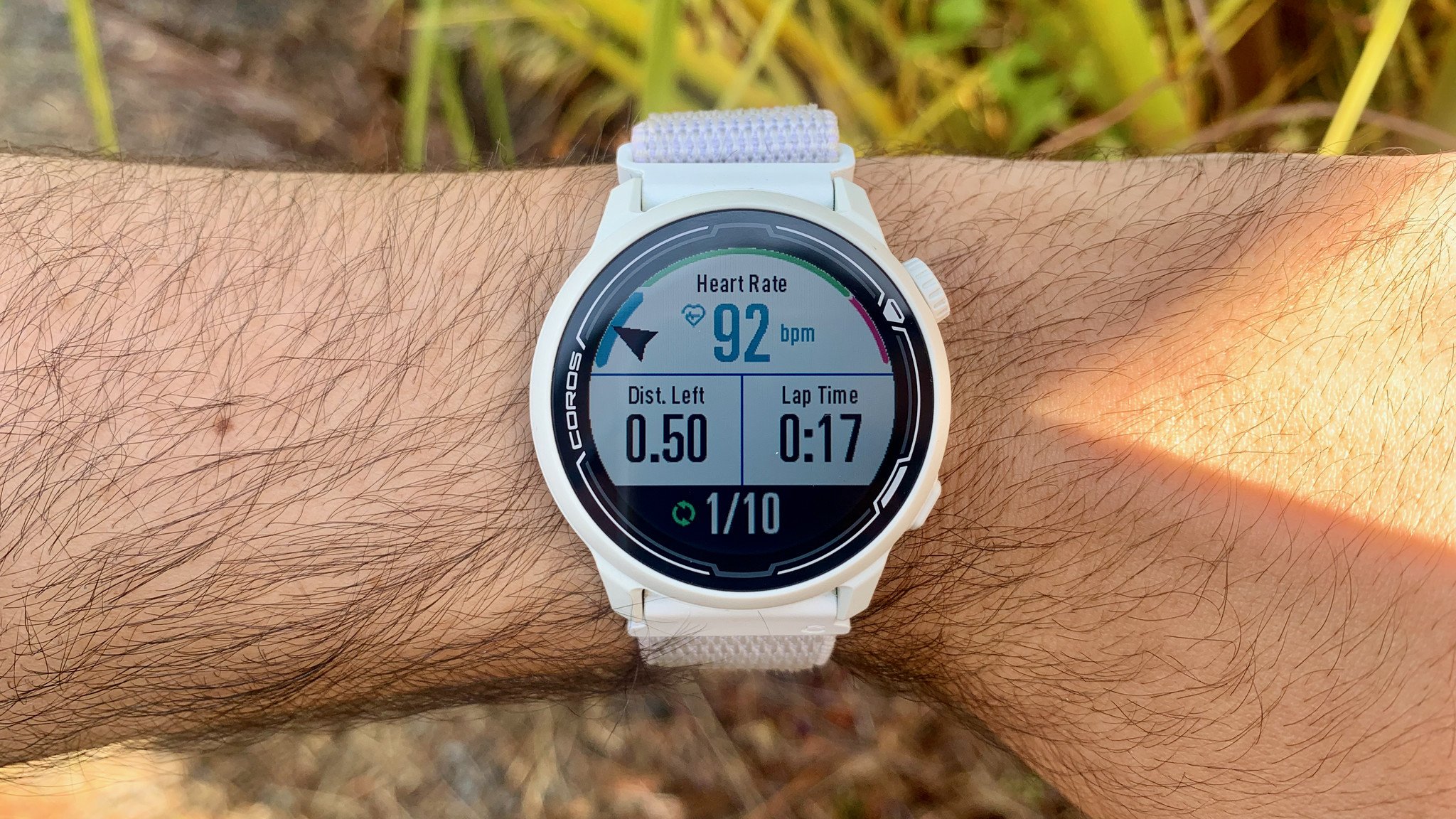
The best competition for the Garmin Instinct 2 Solar comes from other Garmin watches, and depends on what, exactly, you're looking for in a watch. Among the best Garmin watches, the Fenix 7 has the ruggedness and solar-backed battery of the Instinct 2, combined with the touchscreen of the Venu 2 Plus, improved mapping features, and all the sports modes you could want. Unfortunately, it's much more expensive than the Instinct 2.
If you need long battery life but don't like the expensive cost of a Garmin watch, the Coros Pace 2 costs less than half as much, and still hits 30 hours of GPS tracking or weeks of idle tracking despite not having a solar panel. It's also much lighter and gives you free, detailed metrics. But unfortunately, it lacks an SpO2 sensor or NFC payments.
Otherwise, if you're less concerned about battery life and ruggedness, and more about general features, a Garmin Forerunner 255 will give you a more colorful display and more targeted running features, as well as 30 hours of GPS battery life (the same as the non-Solar edition). It certainly can't keep up with the Instinct 2 Solar for battery or for fall protection, but its software advantages make it a better runners watch.
Garmin Instinct 2 Solar: Should you buy it?
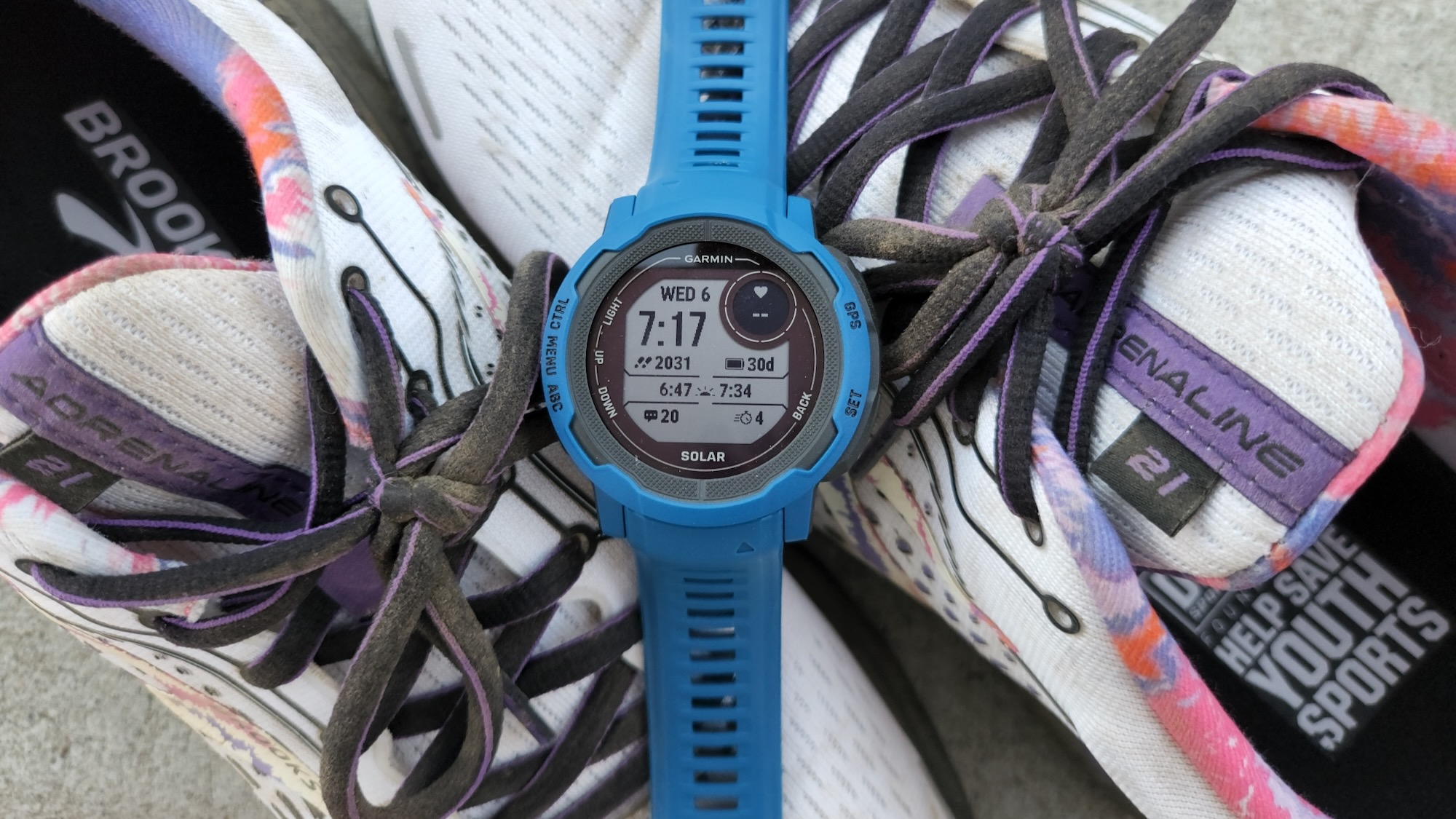
You should buy this if...
- You need a watch that'll never die on the job.
- You work or work out in conditions where your watch could easily get damaged.
- You want detailed fitness metrics without a subscription.
- The Fenix 7 is too expensive for you.
You shouldn't buy this if...
- You want detailed mapping software for outdoor activities.
- You want better synchronization between your watch and phone.
- You want running tips on your wrist while running.
- You don't get much sun in your life.
The Garmin Instinct 2 Solar is fully damage resistant, has all the core fitness data you need, and can recharge naturally by a windowsill (or quickly via USB). It's expensive, but much less expensive than other "adventure" smartwatches.
In the months since this review, I've run with the Polar Pacer Pro, Fitbit Sense, Venu 2 Plus and Forerunner 255, and until the 255 none of them matched the simple competency of the Instinct 2 for me. I'd rather have a battery I could count on to last for days than a flashy display or a more "stylish" design. But that doesn't mean you won't feel differently.
I've since moved on to the Forerunner 255 for the simple reason that it caters to my running needs on the watch, where the Instinct 2 is a bit more dependent on the Garmin Connect app. But I won't deny that I miss its near-endless battery life, which makes even the long-lived 255 look worse by comparison.
I've yet to test a truly "bad" Garmin watch. They all typically have a baseline of quality hardware and software you can rely on, more than most other fitness brands. So you have to trust your instincts and decide whether this watch or another Garmin watch is the one for you. The Garmin Instinct 2 isn't a looker and doesn't have the coolest sport profile features for runners, but it has all the health-tracking essentials and a dependable battery — especially if you buy the Solar panel.
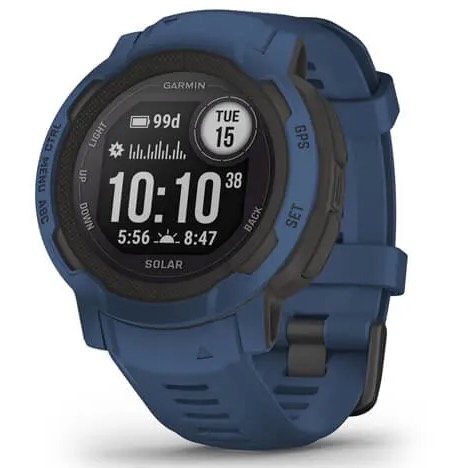
The Garmin Instinct 2 Solar is the marathoner of fitness smartwatches, more than living up to its battery estimates. It lacks the bells and whistles of other Garmin watches but has all the core tracking most athletes need.
Review Changelog
This review was originally published in April 2022. It was updated in August 2022 with the following changes:
- Added the Garmin Forerunner 255 to Competition as a rival pick to the Instinct 2 Solar.
- Noted new Heart Rate Variance feature on Instinct 2 series.
- Changed conclusion to note my time with the watch after the initial review.

Michael is Android Central's resident expert on wearables and fitness. Before joining Android Central, he freelanced for years at Techradar, Wareable, Windows Central, and Digital Trends. Channeling his love of running, he established himself as an expert on fitness watches, testing and reviewing models from Garmin, Fitbit, Samsung, Apple, COROS, Polar, Amazfit, Suunto, and more.
